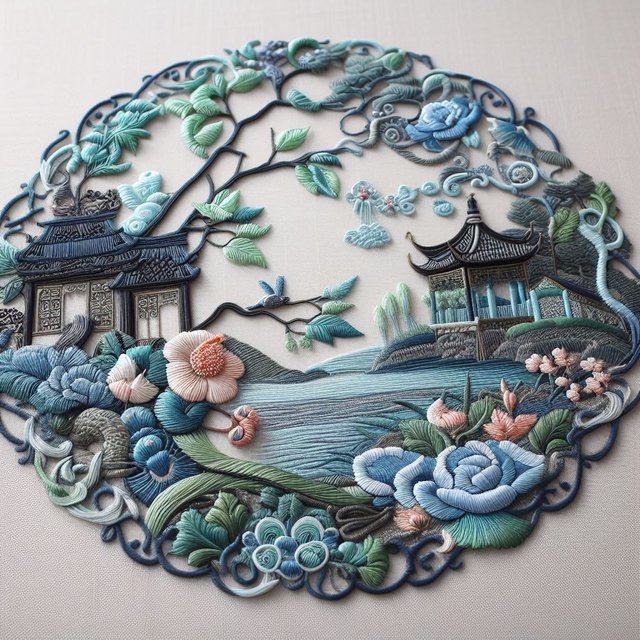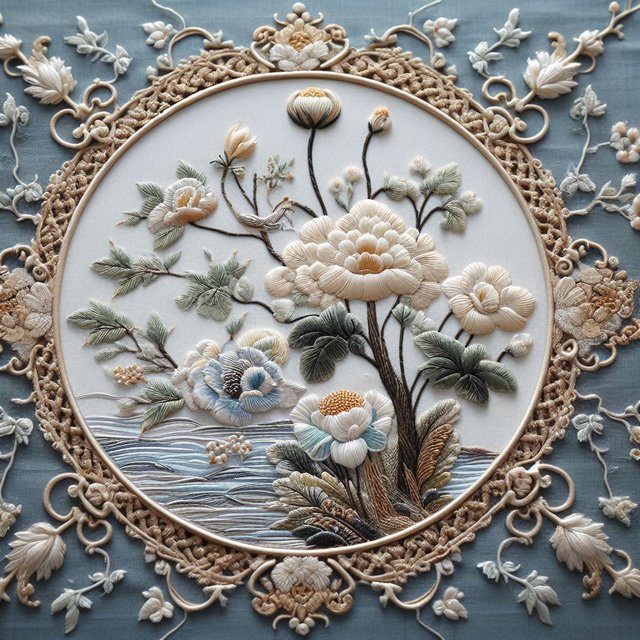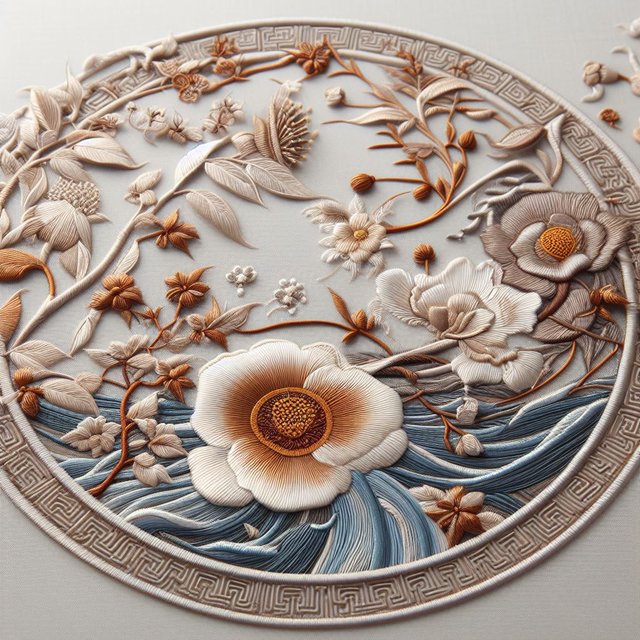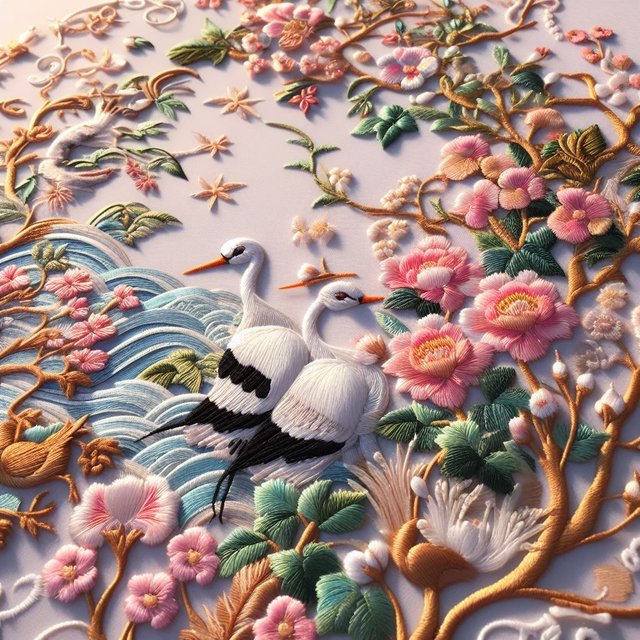
苏绣,起源于苏州,是中国四大名绣之一。早在春秋时期,苏州地区的刺绣技术就已经相当发达。然而,直到隋唐时期,随着经济的繁荣和丝织业的兴起,苏绣才真正发展成为一种重要的手工艺品,这门源远流长的传统刺绣艺术,以其精巧绝伦的工艺和独具特色的审美情趣,不仅成为了中华文化的一颗璀璨明珠,也是世界艺术宝库中的瑰宝。

苏绣的起源可以追溯到春秋战国时期,当时的吴越之地,丝织业已相当发达。到了隋唐时期,随着经济繁荣和丝织业的发展,苏州刺绣逐渐发展成为一种重要的艺术形式。唐代诗人陆龟蒙的《闺怨》一诗中,就描绘了苏州女子静坐房中,以绣花为生的场景。

宋代是苏绣发展的一个重要阶段。当时,苏州一带形成了“家家养蚕,户户绣花”的手工业氛围。在宋代的画卷上,我们常常可以看到苏绣细腻、生动的作品。
明代的苏绣技艺更为精湛。当时的苏州,丝织业和刺绣业都呈现出空前繁荣的景象。明代绣娘甚至能在一方小小的丝帕上,绣出山水、花鸟、人物等种种图案,令人叹为观止。
清代的苏绣更是繁荣发展。乾隆年间,苏州城内有刺绣坊、绣庄等机构数十家,绣工人数超过万人。清代的苏绣作品不仅在技艺上达到了高峰,而且题材也更加广泛,包括历史故事、民间传说等。

苏绣的特点在于其精细入微的工艺和优雅的色彩搭配。苏绣以“平、齐、细、密、均”著称,其针法精细,一丝不苟。常用的针法有几十种,如平针、套针、施针、滚针等。而苏绣的色彩也是其魅力所在。苏绣的色彩丰富多样,可以表现各种场景和情感。同时,苏绣的图案设计富有想象力,既可表现花鸟鱼虫,又可表现山水人物,充满了诗情画意。
苏绣的制作过程精细复杂,需要精湛的技艺和耐心的匠人精神。从选择丝线、设计图案,到一针一线的刺绣,每一个环节都需要精心操作。特别是对于细节的处理,更是考验绣工的技艺水平。一个好的苏绣作品,既是对工艺的传承,也是对匠人精神的赞美。
Suzhou embroidery, originating from Suzhou, is one of the four famous embroideries in China. As early as the Spring and Autumn period, embroidery technology in Suzhou was already quite developed. However, it was not until the Sui and Tang dynasties that Su embroidery truly developed into an important handicraft with the prosperity of the economy and the rise of the silk weaving industry. This long-standing traditional embroidery art, with its exquisite craftsmanship and unique aesthetic taste, not only became a shining pearl of Chinese culture, but also a treasure in the world's art treasure trove.
The origin of Suzhou embroidery can be traced back to the Spring and Autumn and Warring States periods, when silk weaving was quite developed in the land of Wu and Yue. During the Sui and Tang dynasties, with the prosperity of the economy and the development of the silk weaving industry, Suzhou embroidery gradually developed into an important art form. In the poem "Boudoir Complaint" by Tang Dynasty poet Lu Guimeng, it depicts the scene of a Suzhou woman sitting in a meditation room and making a living by embroidering flowers.
The Song Dynasty was an important stage in the development of Suzhou embroidery. At that time, a handicraft atmosphere of "sericulture at home and embroidery at home" was formed in the Suzhou area. In the paintings of the Song Dynasty, we often see delicate and vivid works of Su embroidery.
The Suzhou embroidery techniques of the Ming Dynasty were even more exquisite. At that time, Suzhou saw unprecedented prosperity in both the silk weaving and embroidery industries. The embroidery women of the Ming Dynasty were even able to embroider various patterns such as mountains and rivers, flowers and birds, and characters on a small silk handkerchief, which is breathtaking.
Suzhou embroidery in the Qing Dynasty flourished and developed. During the Qianlong period, there were dozens of embroidery workshops, workshops, and other institutions in Suzhou, with over ten thousand embroidery workers. The Suzhou embroidery works of the Qing Dynasty not only reached their peak in craftsmanship, but also had a wider range of themes, including historical stories, folk legends, and so on.
The characteristic of Suzhou embroidery lies in its exquisite craftsmanship and elegant color matching. Suzhou embroidery is famous for its "flat, neat, fine, dense, and even" stitches, which are delicate and meticulous. There are dozens of commonly used needle techniques, such as flat needle, sleeve needle, needle application, rolling needle, etc. The color of Suzhou embroidery is also its charm. The colors of Suzhou embroidery are rich and diverse, which can express various scenes and emotions. At the same time, the pattern design of Suzhou embroidery is imaginative, which can express not only flowers, birds, fish, and insects, but also landscape characters, full of poetic and picturesque charm.
The production process of Suzhou embroidery is delicate and complex, requiring exquisite craftsmanship and patient craftsmanship. From selecting silk threads, designing patterns, to stitch by stitch embroidery, every step requires careful operation. Especially for the handling of details, it tests the skill level of embroidery workers. A good Suzhou embroidery work not only inherits the craftsmanship, but also praises the spirit of the craftsman.